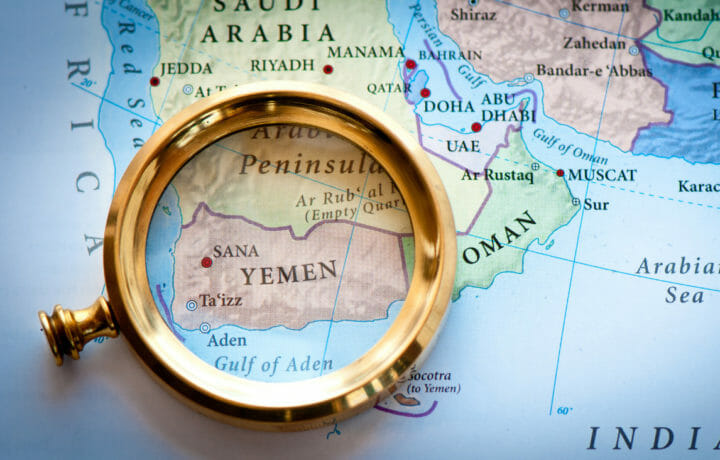U.S. military involvement in the Middle East has wound down in the last few years, but a worsening ground situation in Yemen may change this. Houthi rebels’ warfare against Yemen’s government is not only intensifying, but increasingly spreading into neighboring Saudi Arabia and the United Arab Emirates (UAE) and threatening to wreak havoc in world energy markets and the U.S. economy itself, as well as further inflame U.S. tensions with Iran. All of which gives the United States reason to act.
War Without End in Yemen
Yemen has been a battleground since 2014 between government forces and the Houthis, a Shiite resistance movement taking up arms against what it says is government corruption and greed. Saudi Arabia and the UAE intervened to prop up the Yemeni government, so they’re in the Houthis’ crosshairs, as well.
Houthi forces seized control of much of northern Yemen, took control of the capital city, Sanaa, in 2015, and opened communications with Iran, who’s been providing them with missiles and technical assistance since then.
The United States began sending the Saudis arms and logistical aid that same year. But seven years and more than 130,000 fatalities later—most of them civilian—the Houthis still hold sway over Sanaa and much of the north, and the fighting drags on. Critics have argued that U.S. arms to the Saudis have only made the violence worse, by enabling Saudi-led offensives that have killed horrific numbers of civilians and inspired more enraged Yemenis to join the Houthi cause.
Then came February 2021, when the White House announced an end to U.S. support for Saudi-led operations in Yemen, including “relevant arms sales.” The White House pledged to ramp up diplomatic efforts to stop the violence.
Diplomacy hasn’t borne much fruit, however. Just last week, Houthi drone attacks blew up three oil tanks and killed three people at a UAE oil facility; and started a fire at the Dubai International Airport. A Houthi spokesman tweeted afterward that the group is launching new military operations “deep in the UAE.”
The militants also stepped up their attacks on Saudi Arabia last year, hitting oil facilities, airports, and cities throughout the kingdom with nearly 400 drone and missile strikes—more than twice as many attacks as in the year prior, according to the Center for Strategic and International Studies.
A Plea for Help from Saudi Arabia and UAE
The White House approved a $650 million sale of air-to-air missiles to the kingdom in November. According to U.S. State Department tweets, these missiles are for shooting down incoming Houthi missiles and drones.
But it isn’t enough. The Saudi government warned two weeks ago that its air-defense system could run out of interceptor missiles in the next few months. It issued a plea to regional partners for supplies to replenish its stock.
This isn’t just a Saudi or UAE problem, however. Saudi Arabia is still the source of 10% of worldwide petroleum supplies, so the worsening violence is bound to disrupt oil markets, leading to escalating gas prices and exacerbating inflation. That’s bad news for economies like ours, where consumers are already struggling with surging inflation and high prices at the pump.
“The threat posed by the sharp increase in Houthi attacks could not come at a worse time for a world economy struggling to bounce back from the COVID-19 pandemic,” wrote Matthew Smith in the energy-news site OilPrice.com. “If the Yemeni militants successfully disable significant elements of Saudi Aramco’s petroleum infrastructure, oil prices will spike at a time when substantially higher energy prices are threatening the global economic recovery.”
Arab and U.S. officials also worry about Iran. Tehran and the Houthis being allies, a Houthi takeover could give Iran more power throughout the region.
In Search of a Good Alternative for Yemen
This isn’t a U.S. war; it’s between Yemenis and their ruling regime—and by extension, with the Arab states who chose to intervene on the regime’s behalf. But it becomes a U.S. concern if the region’s oil resources are on the line and if a Houthi takeover strengthens Iran’s hand against U.S. and allies’ interests.
To be clear: No one is calling for deploying U.S. troops to Yemen. But more logistical support and weapons sales are possible.
While these are the very policies the White House had initially rejected, they may be necessary. Critics who argue that arming the Saudis hasn’t quelled the violence are right. But diplomatic talks haven’t pacified the situation, either. The warfare has only gotten more destructive, not less.
It looks as though U.S. leaders and their allies will have to muddle through a combination of U.S.-facilitated negotiations and U.S.-assisted military campaigns. The same policies that have already been tried unsuccessfully. But we can only hope that they’ll be done better this time and will be more successful.



